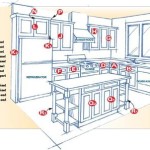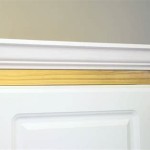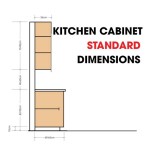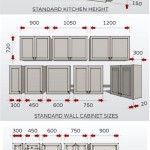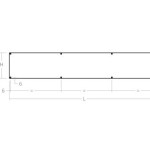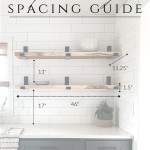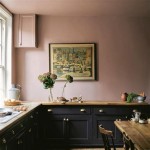Using formatting such as bullet points, numbered lists, and blockquotes can also enhance readability. ## Kitchen Cupboard Wraps: A Comprehensive Guide
Kitchen cupboard wraps, also known as vinyl wraps or cabinet refacing films, offer a cost-effective and visually appealing alternative to completely replacing kitchen cabinets. This method involves applying a self-adhesive vinyl film to the existing cabinet surfaces, providing a refreshed aesthetic without the significant expense and disruption associated with traditional kitchen renovations. The proliferation of options in terms of colors, textures, and finishes has made kitchen cupboard wraps a popular choice for homeowners seeking a quick and impactful update to their kitchen space.
The scope of kitchen cupboard wraps extends beyond merely changing the color of the cabinets. They can mimic the appearance of various materials, including wood grain, high-gloss lacquers, and matte textures. Furthermore, wraps can conceal minor imperfections, such as scratches and dents, on the existing cabinet surfaces. This makes them a practical solution for updating older kitchens or refreshing cabinets that have sustained wear and tear over time.
The application process typically involves careful preparation of the cabinet surfaces, precise cutting of the vinyl film, and meticulous application to avoid air bubbles and creases. While DIY application is possible, professional installation is often recommended to ensure a seamless and durable finish. The longevity of kitchen cupboard wraps depends on factors such as the quality of the vinyl film, the thoroughness of the application, and the level of care taken in maintaining the wrapped surfaces.
Understanding the Benefits of Kitchen Cupboard Wraps
Kitchen cupboard wraps offer a multitude of advantages compared to traditional cabinet replacement or repainting. These benefits range from cost savings and time efficiency to environmental considerations and design flexibility.
*Cost-Effectiveness:
The primary allure of kitchen cupboard wraps lies in their affordability. Replacing entire kitchen cabinets can be a substantial investment, involving the cost of new materials, labor for demolition and installation, and potential plumbing or electrical adjustments. Repainting, while less expensive, still requires purchasing paint, primers, and tools, as well as significant time and effort for surface preparation and application. Kitchen cupboard wraps, on the other hand, offer a fraction of the cost, typically ranging from a few hundred to a few thousand dollars, depending on the size of the kitchen and the complexity of the installation. *Time Efficiency:
Traditional kitchen renovations can be disruptive and time-consuming, often requiring several days or even weeks to complete. During this period, the kitchen may be rendered unusable, necessitating alternative cooking arrangements. Kitchen cupboard wraps, in contrast, can often be applied within a day or two, minimizing disruption to the household. The quick turnaround time is particularly appealing to homeowners who wish to avoid prolonged periods without a functional kitchen. *Design Flexibility:
Kitchen cupboard wraps are available in a vast array of colors, patterns, and textures, providing homeowners with extensive design flexibility. Whether seeking a modern minimalist look or a classic traditional style, there is a wrap to suit almost any aesthetic preference. Furthermore, wraps can be easily replaced if tastes change or if the kitchen decor is updated, allowing for ongoing customization without the significant expense of replacing the entire cabinetry. This flexibility extends to the ability to create unique designs by combining different wraps or incorporating accent pieces. *Environmental Considerations:
Kitchen cupboard wraps can be a more environmentally friendly option than replacing cabinets. By preserving the existing cabinet structures, the need to manufacture new cabinets is eliminated, reducing the consumption of raw materials and energy. Furthermore, discarding old cabinets often contributes to landfill waste. Wrapping, instead, extends the lifespan of the existing cabinets, minimizing their environmental impact. The low VOC content of many modern vinyl wraps also contributes to improved indoor air quality compared to traditional painting methods.Exploring Different Types of Kitchen Cupboard Wraps
The market offers various types of kitchen cupboard wraps, each characterized by different materials, finishes, and application methods. Understanding these distinctions is crucial in selecting the most appropriate wrap for a specific kitchen and desired aesthetic.
*PVC Vinyl Wraps:
Polyvinyl chloride (PVC) vinyl wraps are among the most common and affordable options. They offer good durability and resistance to moisture, making them suitable for kitchen environments. PVC wraps are available in a wide range of colors and finishes, including matte, gloss, and textured options. However, some PVC wraps may contain phthalates, which are chemicals that have raised health concerns. When selecting PVC wraps, it is advisable to opt for those that are phthalate-free. *PET Vinyl Wraps:
Polyethylene terephthalate (PET) vinyl wraps are considered to be a more environmentally friendly alternative to PVC wraps. They are made from recycled plastic bottles and are recyclable themselves, reducing their environmental impact. PET wraps offer similar durability and moisture resistance to PVC wraps and are available in a variety of colors and finishes. They are generally more expensive than PVC wraps, but their eco-friendly properties may justify the higher cost for some consumers. *3D Laminate Wraps:
Three-dimensional (3D) laminate wraps are thicker and more durable than traditional vinyl wraps. They are often used to create realistic wood grain or textured finishes. 3D laminate wraps are typically applied using a heat press, which ensures a strong and seamless bond to the cabinet surface. This type of wrap is particularly well-suited for high-traffic areas or kitchens where cabinets are subjected to frequent use. *Self-Adhesive Films:
Self-adhesive films are the most common type of kitchen cupboard wrap, offering ease of application and versatility. These films come with a pressure-sensitive adhesive backing that allows them to be applied directly to the cabinet surface. Self-adhesive films are available in a wide range of materials, including PVC, PET, and other synthetic polymers. They can be applied by DIYers or professional installers.Addressing Common Concerns and Considerations
While kitchen cupboard wraps offer numerous advantages, potential users should also be aware of certain considerations and potential drawbacks. Addressing these concerns proactively can help ensure a satisfactory and long-lasting outcome.
*Surface Preparation is Key:
The success of a kitchen cupboard wrap installation hinges on proper surface preparation. Before applying the wrap, the cabinet surfaces must be thoroughly cleaned, degreased, and sanded to create a smooth and even base. Any existing imperfections, such as scratches or dents, should be filled and smoothed out. Failure to adequately prepare the surfaces can result in air bubbles, creases, and premature peeling of the wrap. *Durability and Longevity:
The durability of kitchen cupboard wraps depends on the quality of the material, the application technique, and the level of care taken in maintaining the wrapped surfaces. While high-quality wraps can last for several years, they are not impervious to damage. Sharp objects, abrasive cleaners, and excessive heat can scratch or damage the wrap. It is important to use gentle cleaning products and avoid exposing the wrapped surfaces to extreme temperatures. *Professional Installation vs. DIY:
While DIY application of kitchen cupboard wraps is possible, professional installation is often recommended, especially for complex projects or for achieving a flawless finish. Professional installers possess the necessary skills, tools, and experience to ensure a seamless and durable application. They can also address any potential issues, such as uneven surfaces or complex corners, that may arise during the installation process. *Edge Peeling and Adhesive Failure:
Edge peeling and adhesive failure are common issues that can occur with kitchen cupboard wraps. These problems can be caused by inadequate surface preparation, poor-quality adhesive, or exposure to moisture. To minimize the risk of edge peeling, it is important to thoroughly clean and degrease the edges of the cabinets before applying the wrap. Using a high-quality adhesive and sealing the edges with a sealant can also help to prevent peeling. *Matching Existing Decor:
When selecting kitchen cupboard wraps, it is important to consider the existing decor of the kitchen. Choosing a wrap that complements the countertops, backsplash, flooring, and appliances can create a cohesive and aesthetically pleasing design. It is also advisable to obtain samples of the wraps and view them in the kitchen environment to ensure that they match the lighting and overall atmosphere.
Is It Better To Paint Or Vinyl Wrap Kitchen Cupboards

Spray Paint Or Vinyl Wrap For Kitchen Cupboards Upvc Painting

Kitchen Wrap Co Vinyl Wrapping Central Scotland

How Much Does Kitchen Door Wrapping Cost In 2024 Checkatrade

Home

How Much Does Kitchen Door Wrapping Cost In 2024 Checkatrade

Pvc Wrap Doors Diycupboards Com

J Kitchens For Kitchen Wrap Doors High Gloss

Kitchen Vinyl Wrapping Kustom Wraps Ltd

10m Glitter Black Kitchen Worktop Cupboard Door Vinyl Wrap Covering Selfadhesive
Related Posts


